
Things we like
- Incomparable versatility and ruggedness
- More functional with auto transmission
- Improved fuel economy
Not so much
- Very basic specification
- High purchase price
- Not a V8
Muscle memory is an interesting function of the human body.
After driving 70 Series LandCruisers on and off over 30 years, and owning one myself, the action of opening the driver’s door and pulling myself up into the cabin instinctively includes my left boot reaching for the clutch pedal as I land on the slim seat. It took three or four days of living with the new LC79 with its automatic transmission behind a four-cylinder diesel engine before the old habit faded.
Getting into a 70 Series is like pulling on a pair of favourite old work boots, and even though this 2024 updated model brings plenty of changes, the familiarity is still there. Like those old boots, the LC70 remains a favourite workhorse.
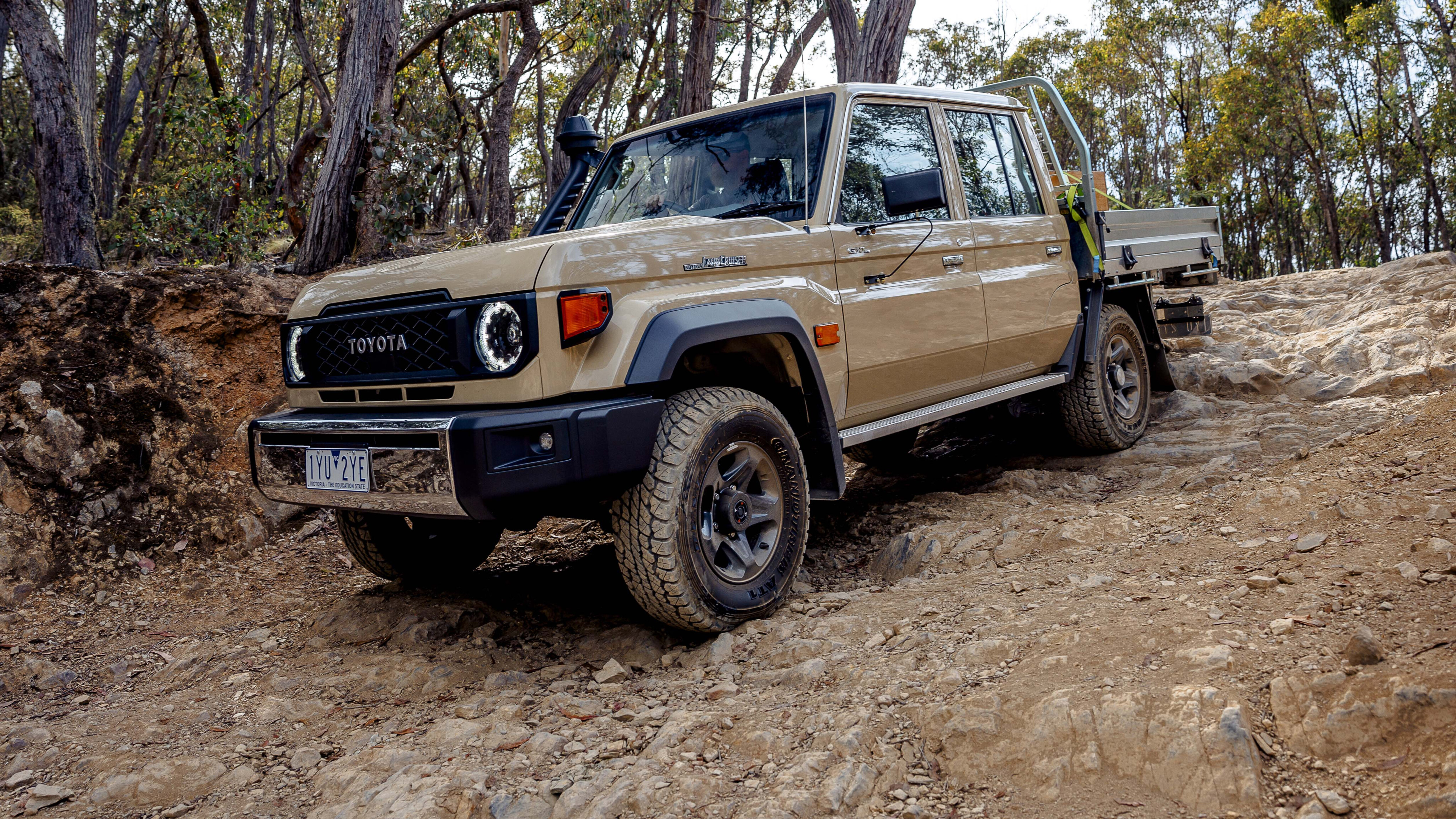
JUMP AHEAD
What's new
Toyota hasn’t messed with its 40-year-old formula when revising the 70 Series for 2024.
It retains a basic commercial body mounted on a heavy duty chassis, with live axles at each end suspended by coil springs under the front and load-lugging leaf springs at the back.
The front sheet-metal has copped a minor update with a blockier style and reverting back to traditional round headlights, albeit with LED halo rings, but the look remains unmistakably 70 Series. There’s even a nod to the old 40 Series in the new grille vent.

The big changes for 2024 have happened behind the grille and in the transmission tunnel, where the 1GD-FTV 2.8-litre four-cylinder diesel engine and Aisin six-speed automatic transmission form the new powertrain.
This engine and transmission are well proven from the Toyota Prado, HiLux and other models, but this is the first time they have been fitted to the 70 Series range. They join the existing 1VD-FTV V8 diesel and five-speed manual driveline combination; although, models fitted with that powertrain will be harder to source from your dealer.
There’s been plenty of consternation about a four-cylinder engine taking the place of a V8 in Toyota’s workhorse 4x4, but with more torque than the standard V8, a similar power figure, the promise of lower fuel consumption, and the improved driveability of an automatic transmission, this new powertrain will appeal to many buyers.

For the record, Toyota quotes the 1GD-powered double cab as using 9.6L/100km on the combined test cycle against 10.7L/100km for the V8 in the same vehicle.
We heard rumours Toyota was testing such a powertrain in the 70 up to four years ago; and while the company was always tight-lipped on it, they have now confirmed there were four such equipped prototypes testing in Australia back then.
To test it for ourselves we took an LC79 GXL double cab with the 2.8/auto combination, loaded it up with 650kg on the tray and hit the tracks.

Capacities
Thanks to the lighter weight of the four-cylinder engine compared to the V8, the four-pot has a higher payload. On the LC79 DC GXL tested here the payload is 1325kg compared to 1250kg for the equivalent V8 model.
All grades and engines have a 3510kg GVM. You also need to take the weight of the tray off that payload as the LandCruiser doesn’t come with one; it’s extra and your payload will depend on what you put on the back, so we reckon our 650kg load was respectable considering we were heading for some steep off-road tracks.
We had a weekend with the Cruiser before we loaded it up and unladen it feels almost sprightly with the 1GD/auto combo, certainly more so than with the V8. The 2.8 gets on with the job and the auto transmission gives nothing to complain about.

We’ve always liked this Aisin six-speed auto in various vehicles from Toyota and other manufacturers.
With the 650kg load on the back and out on the open road, the engine certainly feels the weight. It is less responsive and requires foot-to-the-floor application to maintain the 110km/h speed limit on hills. That said, the V8 was never much good in this regard and we feel the four-cylinder does a better job of it.
Our previous back-to-back testing with a 3100kg caravan behind each powertrain showed this to be the case.

It will be interesting to see how the engine and auto cope with a load on board, and when riding on bigger tyres such as the 33- and 35-inch rubber that many users will fit to their Cruisers.
The rear suspension dropped considerably when the load was added in the tray, but this took some of the jitteriness out of the ride as the vehicle is sprung very stiffly. The ride quality was better with the weight on despite the bum-down, nose-up stance of the laden Cruiser. There was no noticeable lightness of the steering.
The old ball and nut steering box means the 79 has the turning circle of the Queen Mary (15m) but you soon get used to it and learn your limits.
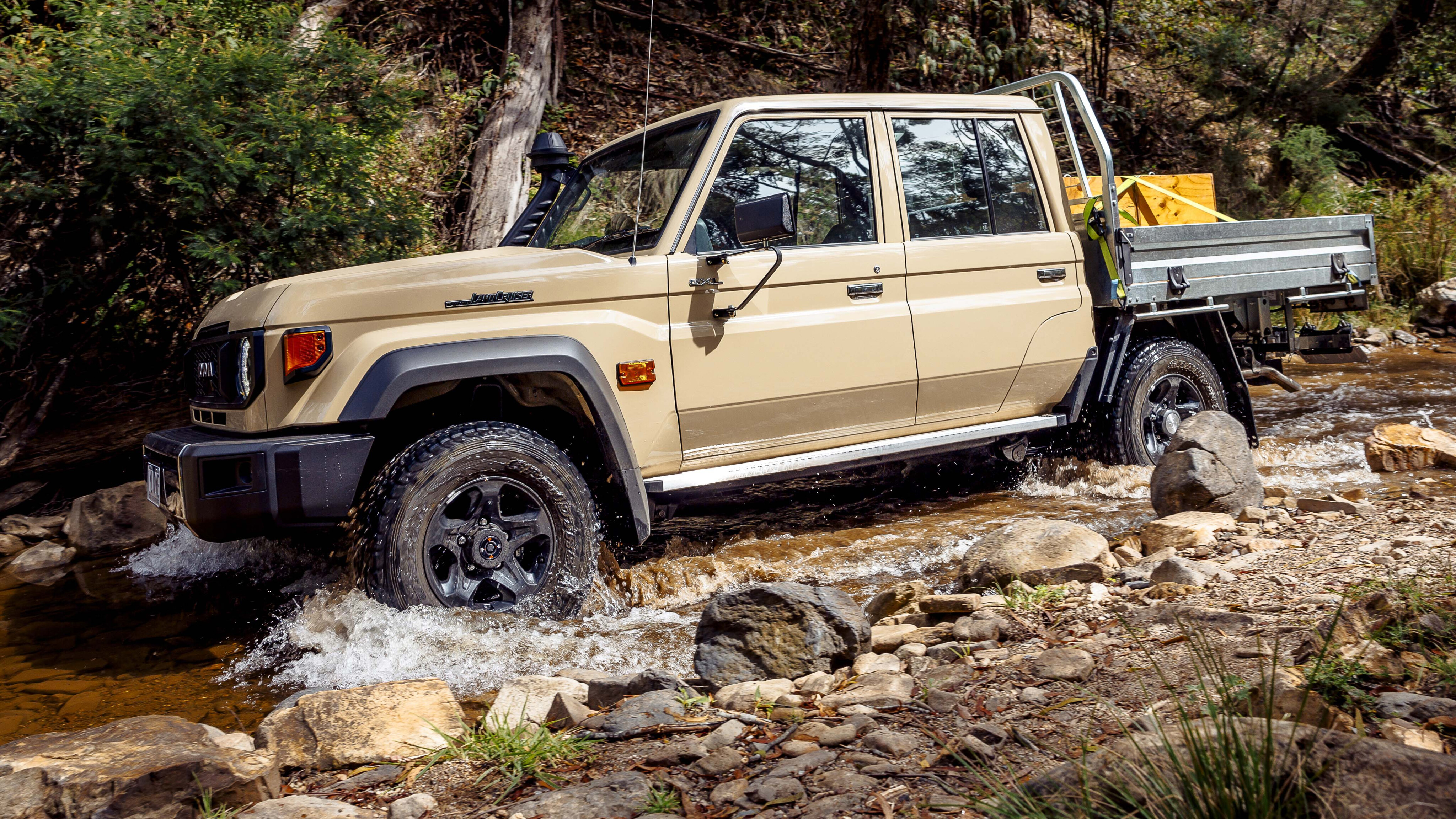
Off-road
A key strength of the 70 Series has always been its ability to haul loads in any conditions, on- and off-road. All 70 variants have a part-time, dual range transfer case for four-wheel drive, and being a GXL model this example has front and rear locking differentials fitted as standard.
LandCruiser 70s with the 1GD/auto powertrain also get downhill assist control that automatically maintains a set speed and manages wheel slip on steep descents. The automatic gives this combo taller overall gearing than the V8 manual, so the electronic assistance comes in handy in steep country.
Less handy is the hill start assistance that holds the brake when you release it to aid hill starts, but is effectively redundant on a vehicle with an automatic transmission.

The load in the Cruiser was again a benefit to the ride quality once we hit unsealed tracks, and the suspension did a good job of soaking up the bumps and potholes.
It’s still a relatively stiff setup and the chassis doesn’t give much flex so the 79 easily picks up wheels in uneven terrain. This is where the differential locks and ETC come in handy.
The auto transmission shifter has a tap-to-the-left gate for manual gear selection and low-range first gear was sufficient for the steep descents on this drive, with the occasional tap on the brakes to steady the ship.
The tall cabin with its large flat windows makes negotiating tracks relatively easy as it gives the driver plenty of visibility for wheel placement. Less accommodating is the location of the rear number plate which hangs low under the tray. This has always been a problem on these factory Toyota trays as the number plate scrapes the ground easily and we’ve lost a few over the years.
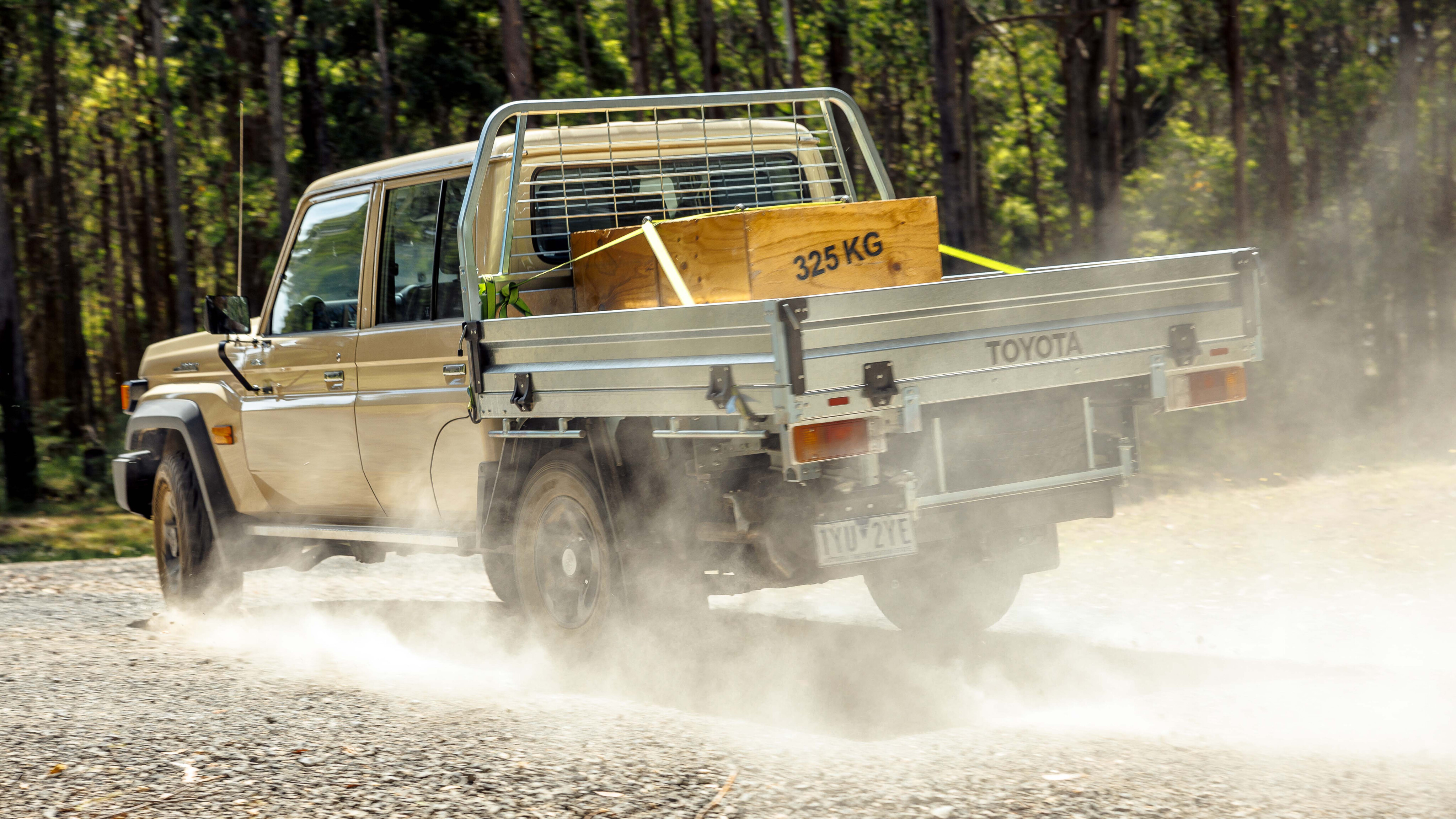
Thankfully we didn’t lose this one and were able to bend it back into shape. There has to be a way to mount it higher up on the tray.
While we’re talking about the tray, the absence of any internal tie-down points makes securing loads harder than it should be; we had to run straps under the side boards and find somewhere on the frame to attach them.
The hooks on the straps we used were too narrow to grip around the external load rails, so securing our load wasn’t as easy as it could have been.
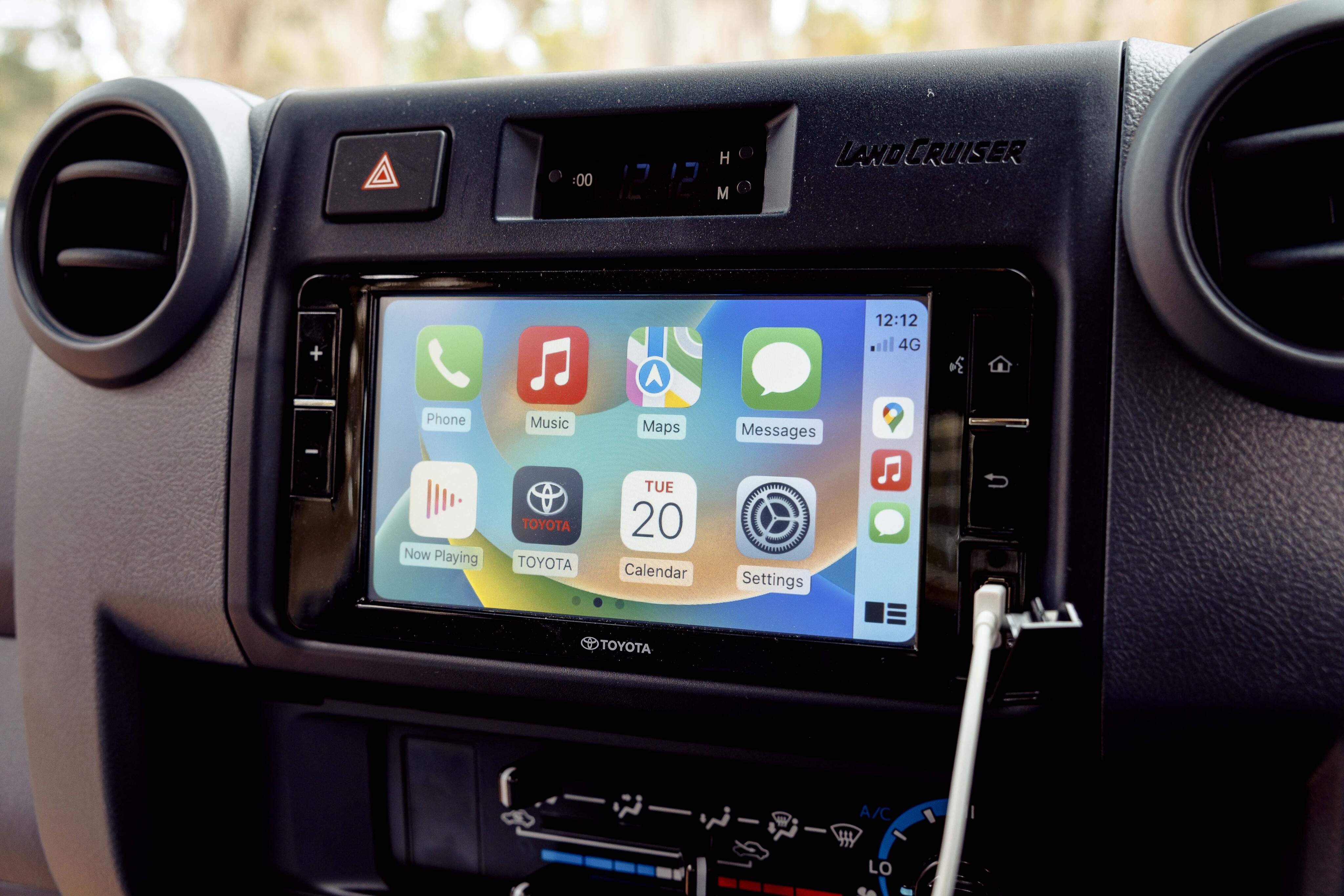
We reckon the flat steel floor of this OE tray will also show its use worse than the chequer-plate floor found in many aftermarket trays.
The 2.8 and auto made light work of climbing out of steep gorges in low range. It was keen to pick up a front wheel when climbing out of ruts, but the standard ETC did such a good job we didn’t need to engage the lockers.
Even in standard trim on the stock tyres, the LandCruiser is an excellent off-road workhorse and you can see why it’s relied upon by so many farmers and industries in the outback and the bush. There really is nothing else like it on the market … yet.
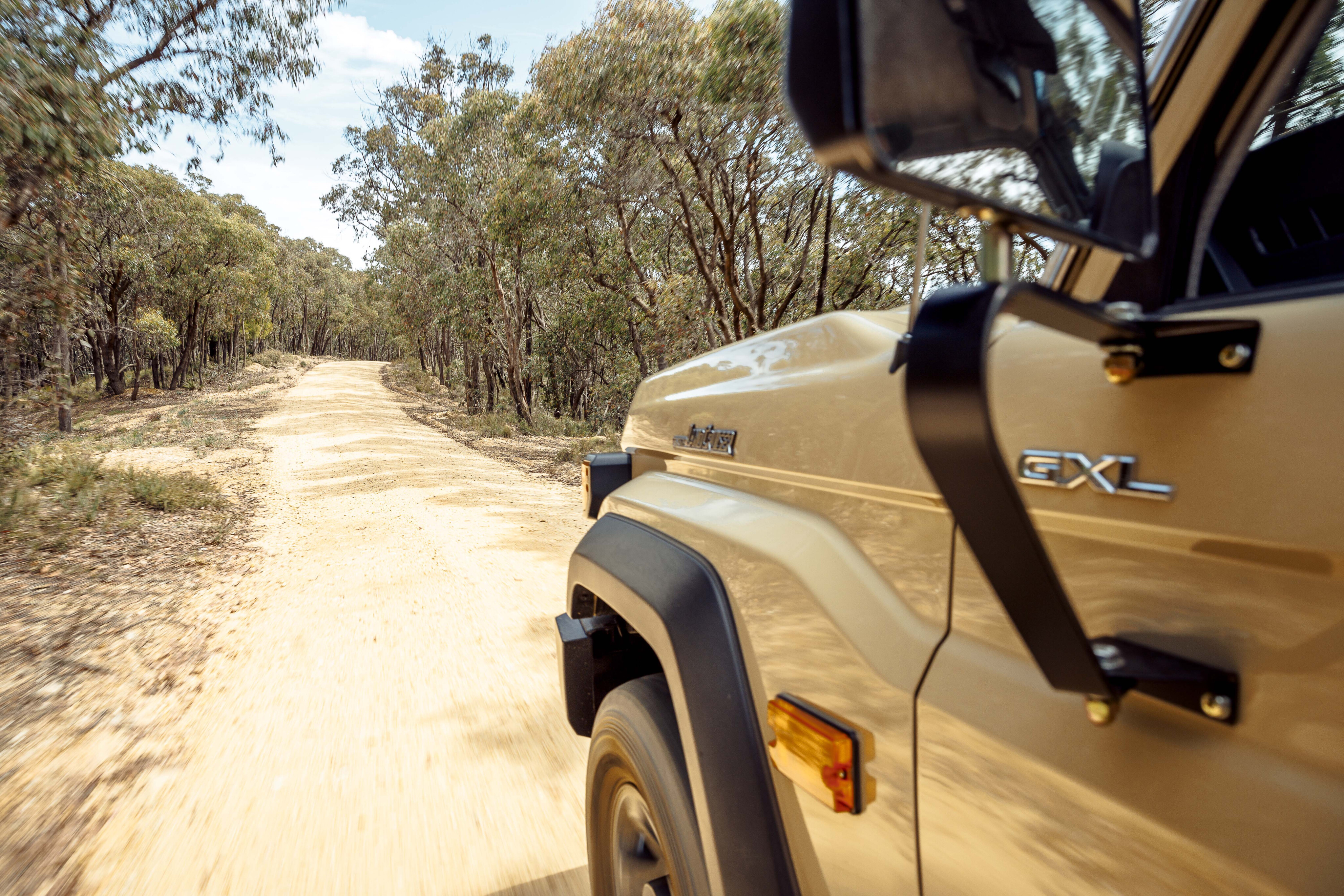
Interior
The LC79 cabin remains a big tin box. Relatively uninsulated when compared to more modern vehicles, it’s tinny and noisy, transmitting road noise through the chassis and plenty of wind noise around the A-pillars and raised air intake. It really lets you know that the 70 is a commercial vehicle.
The GXL gets some concessions such as power windows and cloth seats, and there’s a new infotainment screen that is small by modern standards but it allows you to hook up your phone for Apple CarPlay and Android Auto.
The sound from it is shocking, as it still pumps out through a pair of paltry four-inch speakers mounted in the dash panel. It’s no wonder aftermarket sound-deadening kits and audio-system upgrades are big business for these Cruisers.
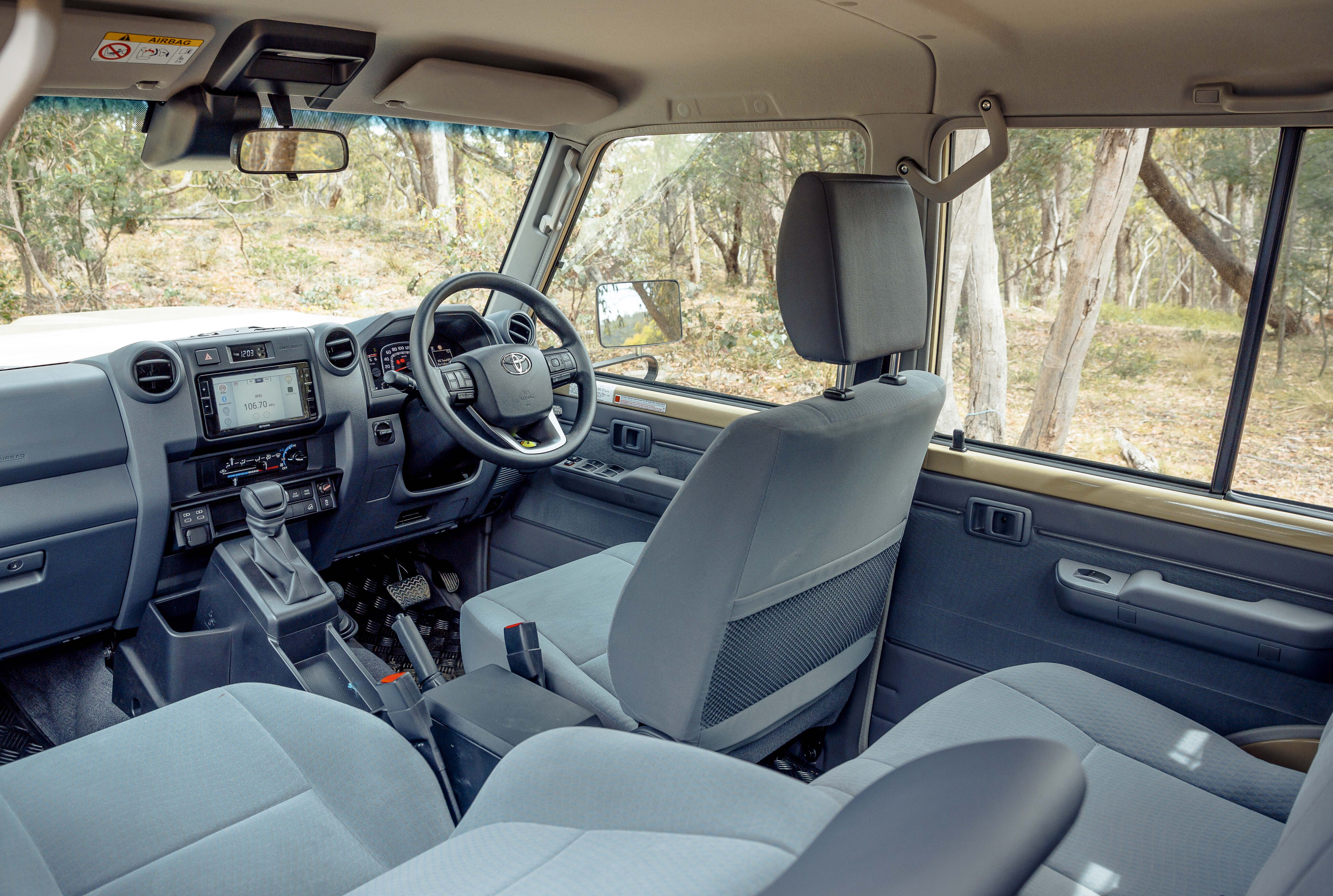
New for the 2024 70 Series range is a fresh gauge cluster that is another nod to the 40 Series with its retro electronic gauges.
This is one of my favourite parts of the new 70 as I love the look, and having a digital speed readout in the 4.2-inch display is always a plus when driving in Victoria. Speed sign recognition in the same panel is also welcome.
The seats are slim but comfortable enough, but again you can see why many owners choose to fit aftermarket options. The rear seat has plenty of room for three passengers but adults will be shoulder-to-shoulder back there.
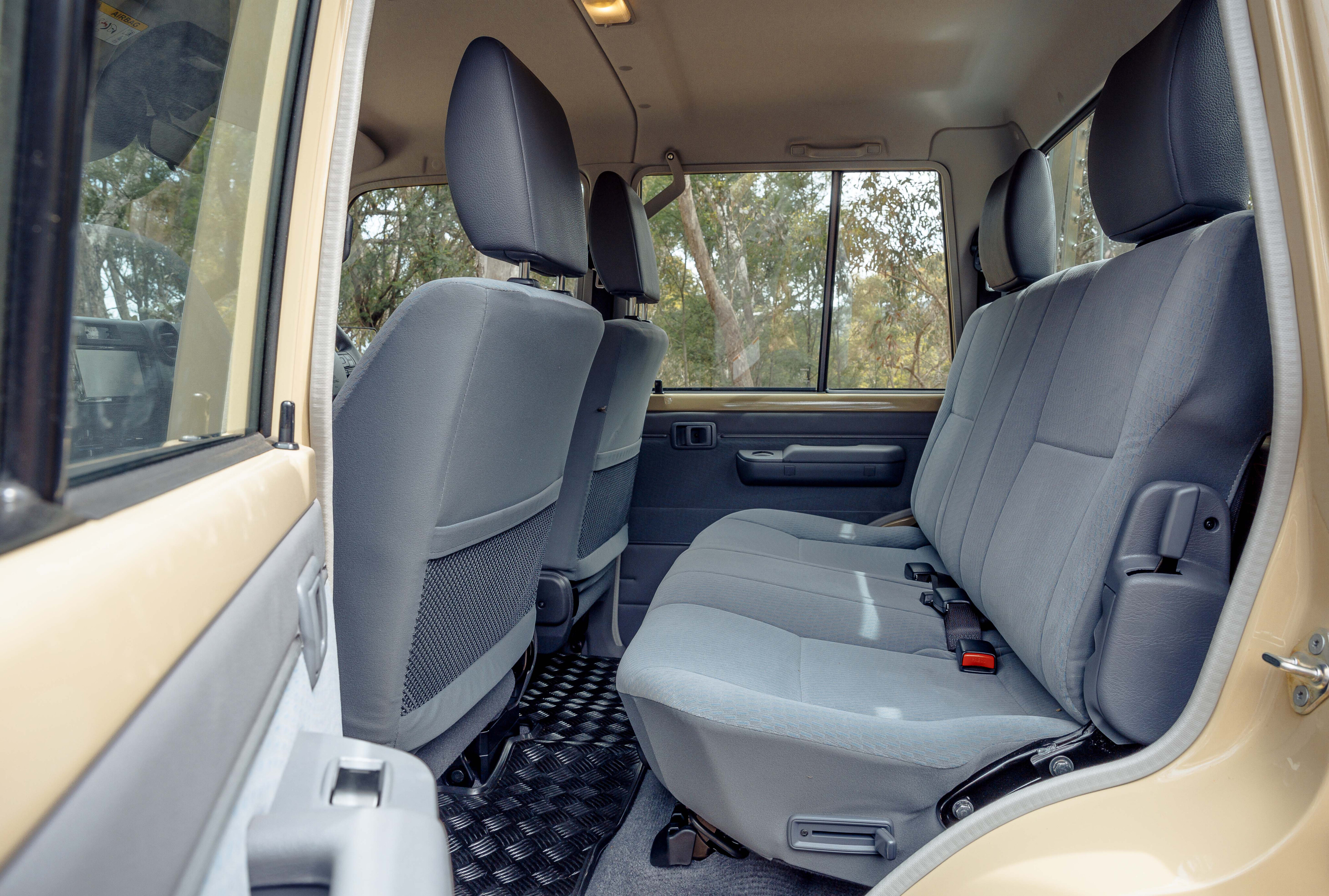
Safety
Safety-wise the new features include lane departure warning, pre-collision system with pedestrian and daytime cyclist detection and intersection assistance, stability control, brake assist, and electronic brake force distribution.
It’s small steps forward in terms of safety when compared to newer vehicles but when you consider Toyota is building on a 40-year-old platform, any advance is a step forward.
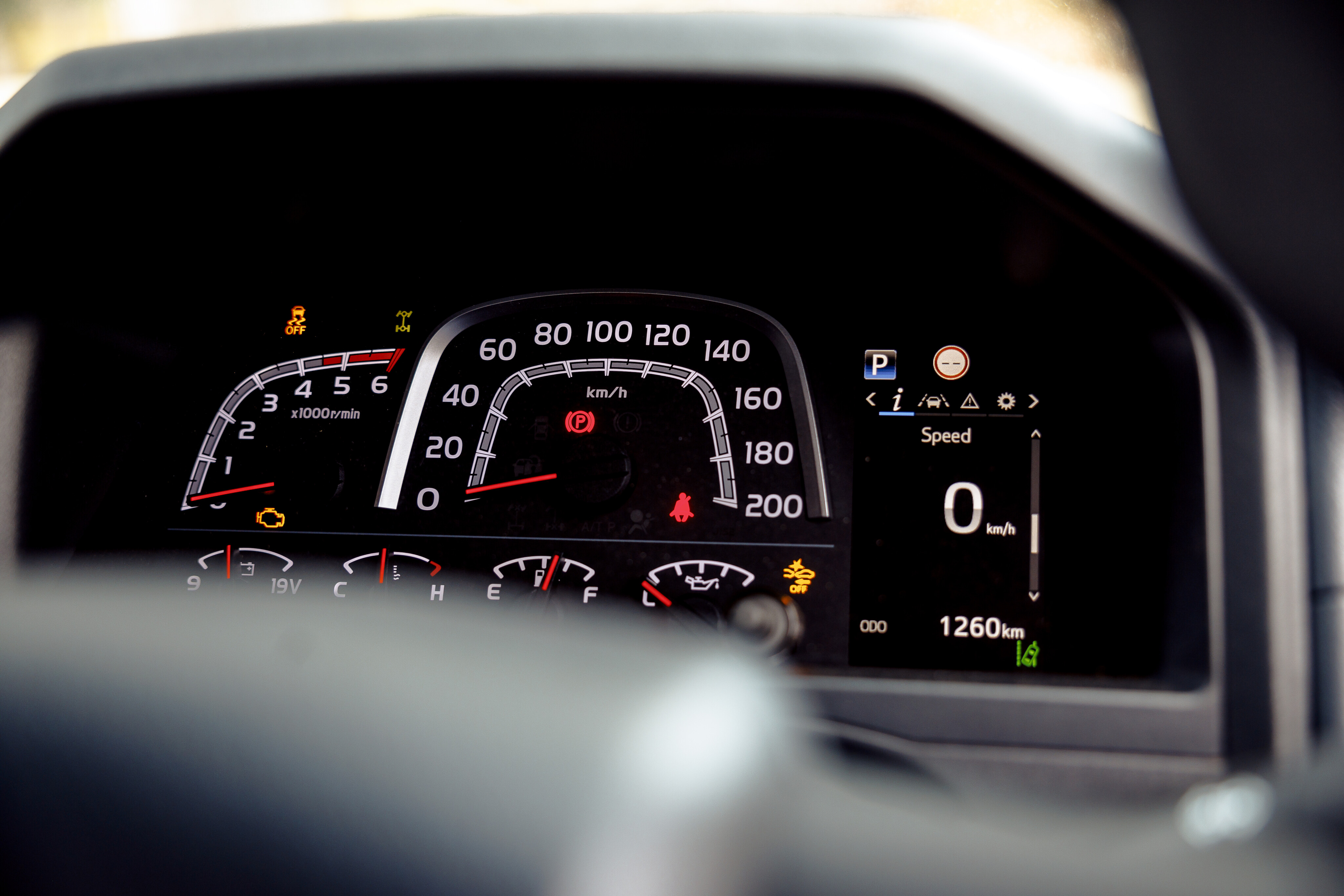
Verdict
The LandCruiser 70 Series isn’t about the latest safety, comfort and convenience features; many of these features have been forced upon it just so it can be sold in modern times.
Likewise the introduction of the 1GD 2.8 engine is future proofing the iconic workhorse against possible changes to emissions regulations which might soon rule out the 1VD V8 engine from Australian sales, while at the same time introducing an automatic transmission to fill that hole in the market.
Of course, there will still be those who call out for an auto behind the V8, whereas I feel the best combo would be a six-speed manual behind the 2.8; everyone wants something different, which is why the 70 Series remains one of the most customised 4x4s on the market.
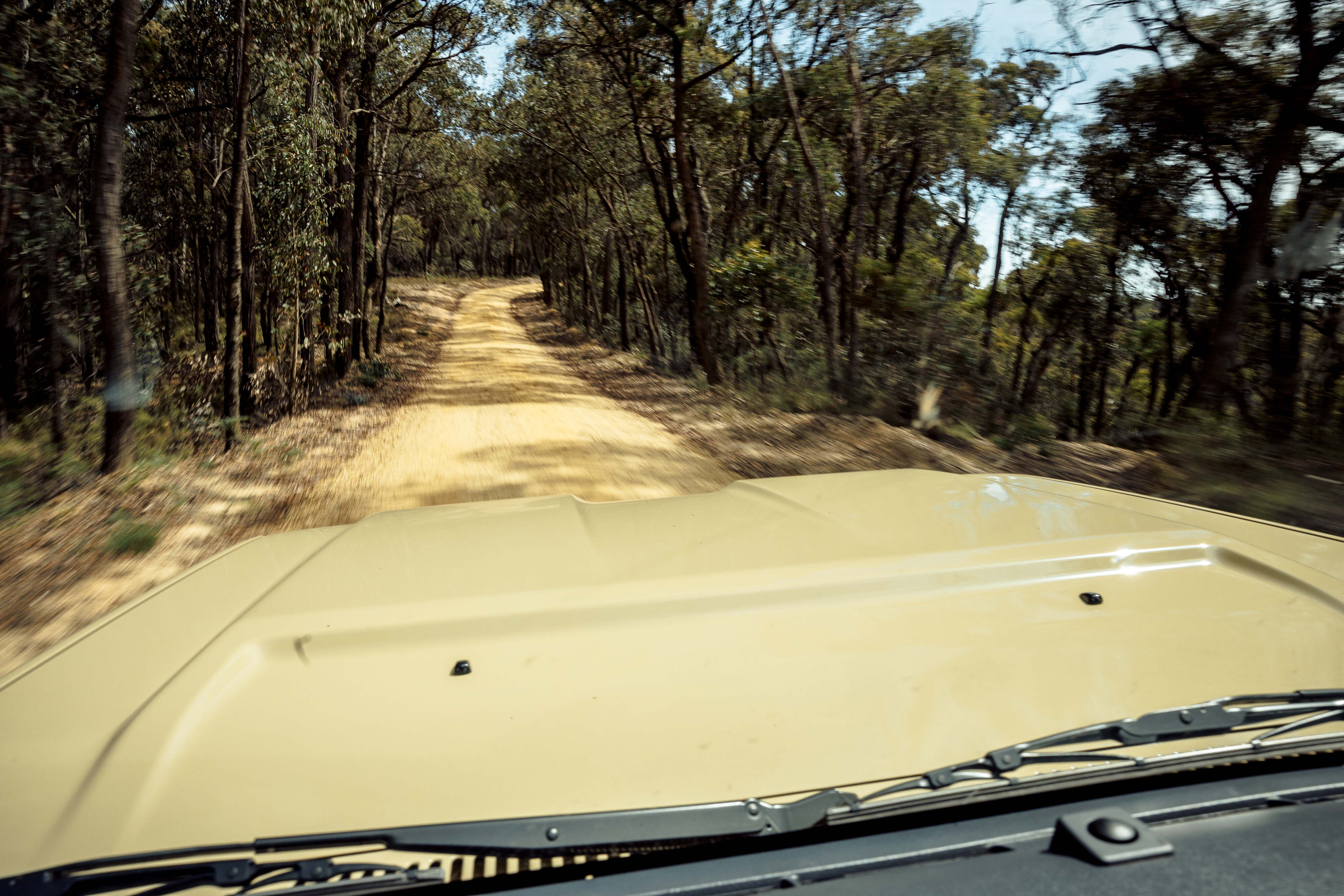
The 2.8/auto powertrain brings the 70 back to being more of a workhorse than a hot rod, as some treat the V8 these days.
With this new drivetrain the 70 is a better-working truck suited to more industries and drivers which is what it was originally designed to be more than 40 years ago.
The 70 Series Cruiser, no matter what model you choose, remains a unique vehicle in the market and we should appreciate what has been done to keep it available to us. There is nothing else like the LC79; ever since Nissan stopped building its Patrol ute and Land Rover its Defender pick-up, the LC79 has been in a class of its own.
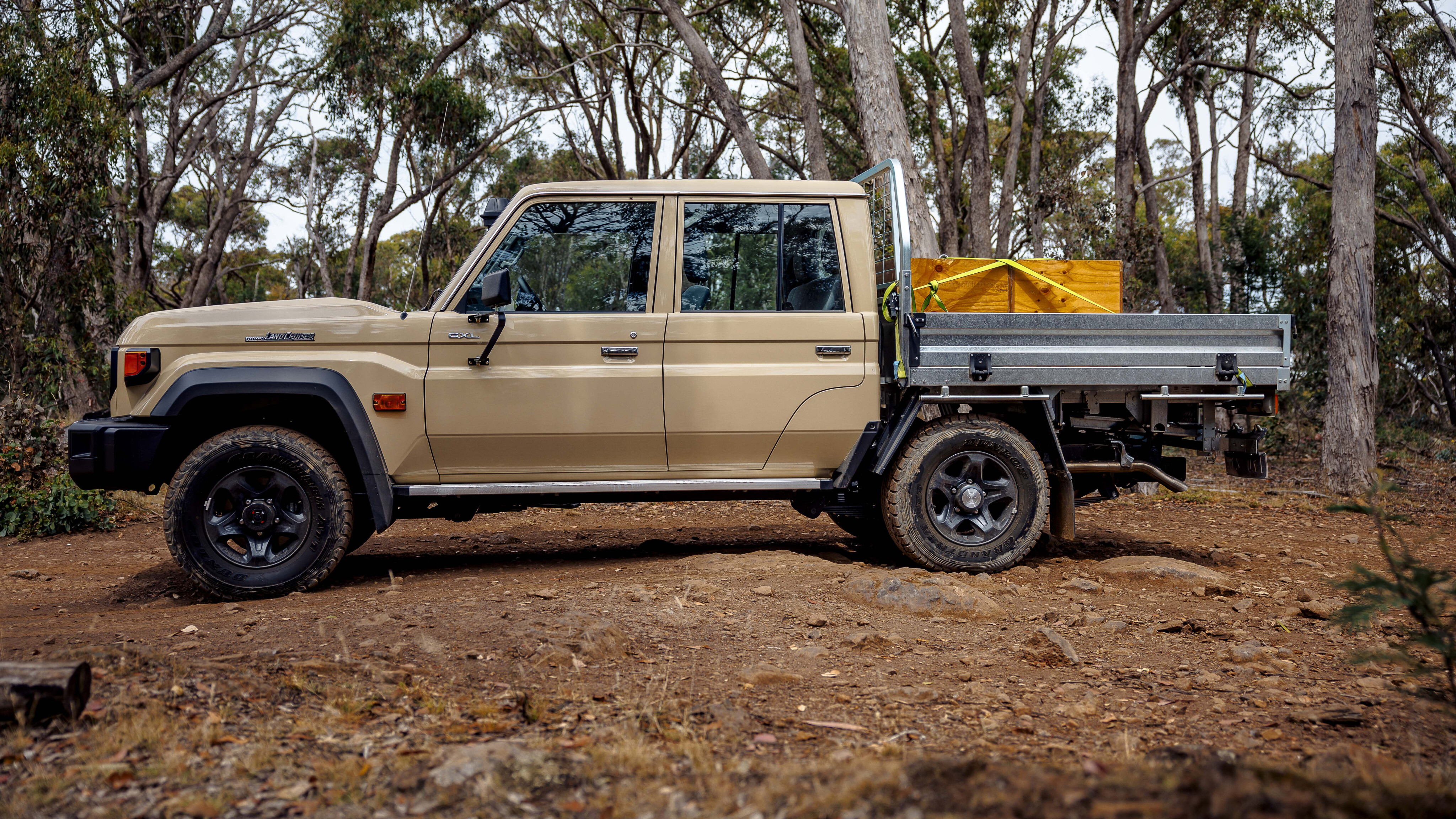
Big American pick-ups don’t come near the 70 for off-road ability and rugged durability.
It’s made to carry loads over rough tracks all day, every day. Likewise, no midsize 4x4 ute can match the capabilities of the 70 when the going gets tough. It will be interesting to see how the Ineos Quartermaster compares to the 79 when it is released later this year but it has four decades of glacier-paced development to catch up on.
While there are plenty criticise the 70 for its basic design and high price, I reckon we should be grateful that it is still with us.
Specs
| 2024 LandCruiser GXL 79 Double Cab 2.8 specifications | |
|---|---|
| Price | $83,500 |
| Engine | Inline 4 diesel |
| Capacity | 2755cc |
| Max power | 150kW@3000-3400rpm |
| Max torque | 500Nm@1600-2800rpm |
| Transmission | 6-speed automatic |
| 4x4 system | Part-time 4WD, dual-range, front and rear lockers |
| Crawl ratio | 38.51:1 |
| Construction | 4 door ute body on ladder frame chassis |
| Front suspension | Live axle with radius arms and coil springs |
| Rear suspension | Live axle on leaf springs |
| Tyres | 265/70RR16 on alloys |
| Kerb weight | 2185kg |
| GVM | 3510kg |
| GCM | 7010kg |
| Towing capacity | 3500kg |
| Payload | 1325kg |
| Seats | 5 |
| Fuel tank | 130L |
| ADR fuel consumption | 9.6L/100km combined |
| On-test fuel consumption | 14.01L/100k |
Things we like
- Incomparable versatility and ruggedness
- More functional with auto transmission
- Improved fuel economy
Not so much
- Very basic specification
- High purchase price
- Not a V8



COMMENTS